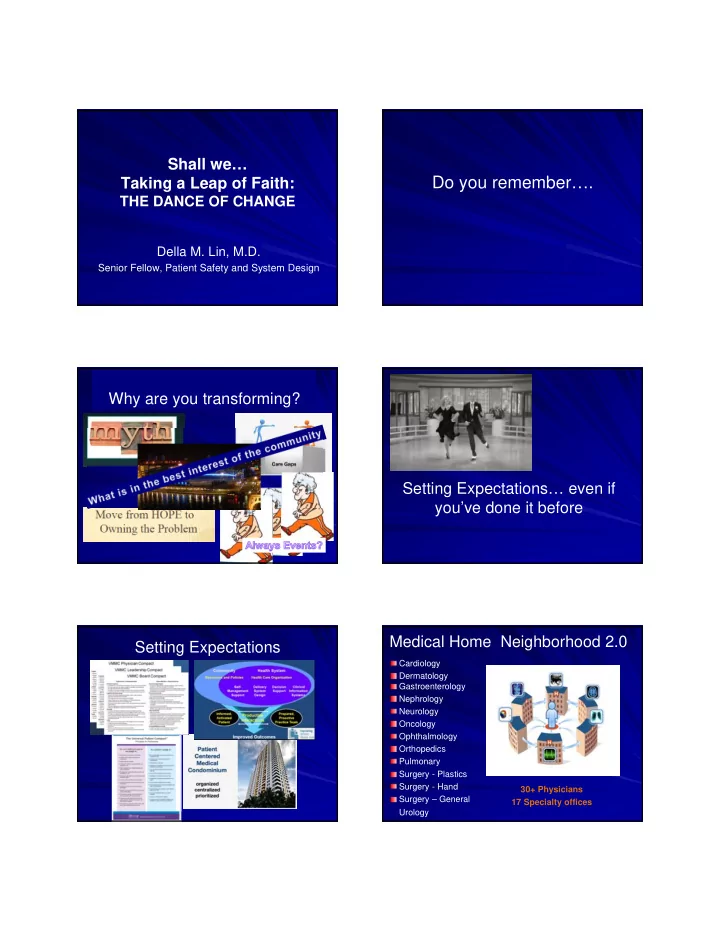

Shall we… Do you remember…. Taking a Leap of Faith: THE DANCE OF CHANGE Della M. Lin, M.D. Senior Fellow, Patient Safety and System Design What do you want this “dance” Why are you transforming? to look like… and not look like Setting Expectations… even if you’ve done it before Medical Home Neighborhood 2.0 Setting Expectations Cardiology Dermatology Gastroenterology Nephrology Neurology Oncology Ophthalmology Orthopedics Pulmonary Surgery - Plastics Surgery - Hand 30+ Physicians Surgery – General 17 Specialty offices Urology
Primary Care-Specialty Care Compacts Defining Expectations Collaborative Care Management Mutual Agreement Co-management Referral Define responsibilities between PCP, specialist and patient. Clarify who is responsible for specific elements of care (drug therapy, referral management, diagnostic testing, care teams, patient calls, patient education, monitoring, follow-up). Maintain competency and skills within scope of work and standard of care. Give and accept respectful feedback when expectations, guidelines or standard of care are not met Agree on type of specialty care that best fits the patient’s needs. Principle Expectations Care of Disease Primary Care Specialty Care Follows the principles of the Patient Centered Medical Home Reviews information sent by PCP or Medical Home Index. Addresses referring provider and patient concerns. Manages the medical problem to the extent of the PCP’s Confers with PCP or establishes other protocol before orders scope of practice, abilities and skills. additional services outside practice guidelines. Obtains proper Follows standard practice guidelines or performs therapeutic prior authorization. Confers with PCP before refers to secondary/tertiary trial of therapy prior to referral, when appropriate, following evidence-based guidelines. specialists for problems within the PCP scope of care and uses Reviews and acts on care plan developed by specialist. a preferred list to refer when problems are outside PCP scope Resumes care of patient when patient returns from specialist of care. Obtains proper prior authorization when needed. care. Sends timely reports to PCP to include a care plan, follow-up Explains and clarifies results of consultation, as needed, with and results of diagnostic studies or therapeutic interventions. the patient. Makes agreement with patient on long-term Notifies the PCP office or designated personnel of major treatment plan and follow-up. interventions, emergency care or hospitalizations. Prescribes pharmaceutical therapy in line with insurance formulary with preference to generics when available and if appropriate to patient needs. Provides useful and necessary education/guidelines/protocols to PCP, as needed Anticipation: Organized setting Fewer ED visits of expectations ED visits/1000 450 400 350 300 250 200 ED visits/1000 150 100 50 0 US Colorado Westminster Practice Reducing Variation with through tools and data
Data, Tools and Feedback There is Data for Reporting AND There is Data for Improvement Adult CLABSI Rates have dropped Hawaii Median Rate at Zero by > 80% Statewide 1 1.8 0.9 1.55 0.8 1.6 CLABSI per 1000 line days 0.7 1.25 1.4 0.6 1.33 0.5 1.2 0.4 0.3 1 0.2 0.71 0.58 0.57 0.8 0.1 0 0 0 0 0 0 0 0 0 0 0 0 0.6 0.37 0.4 0.12 0.25 0.13 0.2 0.12 0 Median ICU CLABSI Rate in Hawaii Reducing Variation through Data, Tools Hawaii ICU-CLABSI : and Feedback # Days between infections increasing from 2009- present 160 134 days! Days between CLABSI infections 140 >76 days 120 and counting ! 100 80 Up is Good! 60 Mean + 3 sigma = 36 days Days between CLABSI infections 160 40 140 120 20 Mean = 9 days 100 (Median = 5 days) 80 0 1 3 5 7 9 11 13 15 17 19 21 23 25 27 29 31 33 35 37 39 41 43 45 47 49 51 53 55 57 59 61 63 60 Timeline 40 2011 20 2009 CLABSI 2010 CLABSI CLABSI 0 Jan-Dec : 41 Jan-Dec:16 Jan- 1 5 9 13 17 21 25 29 33 37 41 45 49 53 57 61 Dec: 7
Tap into Unexpected Partners Unexpected Partners Innocentive Challenge grant to design games to improve medication adherence Patients in Remission Increased from 50% to 77% Who else is sharing the stage? Avoiding unintended consequences
Improvement in Short term Outcome in Heart Failure Patients LOS dropped from 8.8 to 6.3 days Hospital mortality dropped: 8.5 to 4.3 % 30 day mortality dropped: 12.8 to 10.7% 30 day readmission increased: 17.1-20.1% Post-discharge mortality increased: 4.3-6.4% Discharges to SNF increased 13-20% JAMA 2010 303 (21):2141-7 TRIPLE AIM: Watching others on the same stage 45% 1.000 42% 97.1% 0.980 97.7% 35% Total Cost Index 0.960 95% 25% 0.940 Design Leadership 0.920 15% 0.900 0.8987 90% 0.880 5% % patients with % patients “Would Total Cost Index Optimal Diabetes Recommend” ( compared to statewide average ) Control HealthPartners Clinics < 1 is better than network average “The wicked leader is he whom the people revile. What should be the purpose The good leader is he whom the people revere. of the healthcare system for The great leader is he of whom the people this city and its future? say…’We did it ourselves’” … Lao Tzu Columbus Health Care System, Walk Out Walk On
• What do you need and want? • Define Expectations What do you need and want? • Real time feedback • Know who else is on the stage with you • Embrace old and new partners • Hidden Leadership • Performance excellence can’t be scripted
Recommend
More recommend